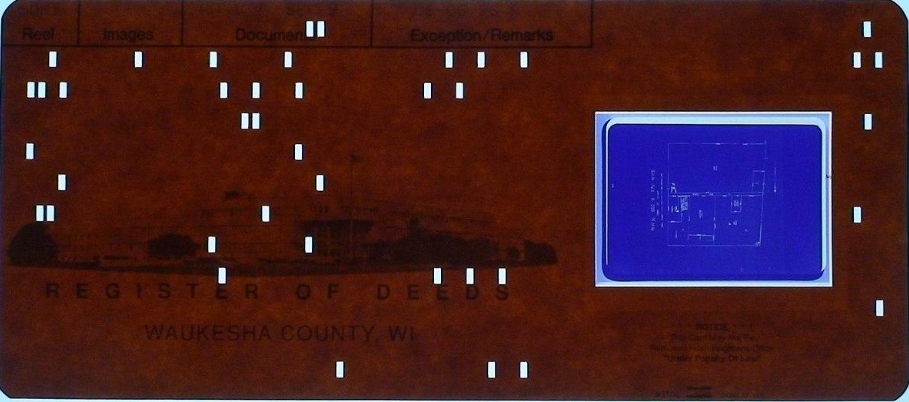
If you haven’t ever seen an aperture card, it’s not surprising. Aperture cards were once considered the apex of photography technology and were a staple in data storage and archiving.
For those unfamiliar, aperture cards are a microfilm format that housed a single frame of film encased in a paper card. They offered a compact and durable way to store large volumes of documents, particularly popular from the 1960s to the 1990s. Each card contains a cut-out section that holds a microfilm image, offering a compact and durable way to archive large amounts of information. These cards were especially popular in aerospace, manufacturing, and government industries, where precise and accessible documentation was essential.
However, with the rise of digital technology, aperture cards began to collect dust in archives, their retrieval a cumbersome process compared to the instant access of digital files.
Today, aperture card scanning services play a vital role in preserving these important documents by converting them into digital formats. These scanners bridge the gap between the legacy of aperture cards and the efficiency of digital documents.
But simply converting aperture cards to digital files isn’t enough. Choosing the optimal file format for your scanned documents is crucial for long-term usability and accessibility. Here’s where Smooth Solutions‘ expertise truly shines.
Evolution of Aperture Card Scanners
With technological advancements, the need for more efficient and accessible storage solutions became apparent. Aperture card scanners are vital for converting physical microfilm images into digital files. Early scanners were limited in functionality and speed, but modern scanners now offer high-resolution imaging, faster processing times, and enhanced features like automated feeding and indexing.
Choosing the Optimal File Format for Aperture Card Digitization
The vast array of digital file formats can be overwhelming. Selecting the correct format for scanning aperture cards is essential for maintaining quality, accessibility, and compatibility. Some popular formats to consider are:
- PDF (Portable Document Format): PDFs are the universal document formats that are widely recognized and compatible with most operating systems. They excel at preserving your documents’ original layout and formatting, which means they can be reproduced the same way in the future. This makes them ideal for contracts, invoices, and similar documents where presentation matters.
- JPG (JPEG): A popular image choice, JPGs (Joint Photographic Experts Group) offer good compression, reducing file size without significant visual degradation. This makes files smaller and easier to manage, making them suitable for scanned photographs or simple documents with minimal text. However, JPGs may not be ideal for text-heavy documents due to potential loss of clarity. That’s why it’s most commonly used for photos and general-purpose images.
- TIFF (Tagged Image File Format): TIFFs are known for their lossless compression, meaning they preserve every detail of the original image. This makes TIFF an optimal choice to scan aperture cards to get high-resolution copies of critical documents where maintaining every detail is essential, such as in healthcare and engineering. However, TIFFs can result in larger file sizes compared to JPGs.
- PNG: Portable Network Graphics (PNG) provides lossless compression, ensuring no data is lost during the digital aperture card conversion. It also supports transparency, making it a good choice for web graphics and images requiring a transparent background. This format is particularly useful for graphics that need to maintain high quality while having transparent elements, such as logos and icons used in web design. Additionally, PNG files are widely supported across various platforms and software, ensuring compatibility and ease of use.
Importance of Aperture Card Scanning Services
Aperture cards, once a popular method for storing large volumes of information, have become obsolete with the advent of digital technology. Scanning aperture cards into digital format offers numerous advantages:
Improved Accessibility and Efficiency
Digital files can be accessed instantly, eliminating the time-consuming process of locating and retrieving physical cards. Plus, documents can be accessed from anywhere via the internet, enhancing collaboration and productivity.
You can also share digital files retrieved from aperture cards among multiple users simultaneously, improving workflow efficiency.
Cost Reduction
Scanned aperture cards require significantly less storage space compared to physical aperture cards. Moreover, they eliminate the need for aperture card readers and other related maintenance costs.
Plus, the aperture card digitization services are automated, reducing the manual labor in handling physical cards.
Data Preservation and Security
Digital files can be backed up and stored securely to protect against physical damage, loss, or deterioration. These backups ensure business continuity in case of emergencies.
Digitized aperture cards can be protected with encryption and access controls to safeguard sensitive information.
Enhanced Search and Analysis
Digitized aperture cards can be easily searched using keywords or metadata, allowing for rapid retrieval of specific information. Their data can be analyzed and processed using advanced software tools to extract valuable insights.
Digital files can also be integrated with existing document management systems and business applications.
In short, aperture cards to digital services provide a bridge between the past and the future, giving you access to your archived information and enabling you to leverage it for improved efficiency, cost savings, and better decision-making.
Bottom Line
While aperture card scanners have played a vital role in preserving the past, the future of document management lies in cloud-based solutions and advanced document capture technologies.
To gain an edge in the digital world, organizations now need to invest in digitized solutions, including aperture card scanning services that cater to the ever-evolving needs of their clients.


